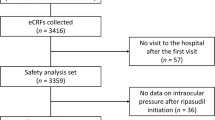Abstract
In Asia, there is a need for agents to treat chronic angle closure glaucoma. This article highlights factors in determining whether to conduct an active or placebo control study and special circumstances that increase the complexity of this decision in clinical trials for chronic angle glaucoma trials. The authors advise the use of a placebo control design in pivotal clinical trials dealing with chronic angle closure glaucoma. Once a medication is approved for use in chronic angle closure glaucoma, subsequent pivotal trials of similar drugs can use an active control design.
Similar content being viewed by others
References
Foster PJ, Baasanhu J, Alsbirk PH, et al. Glaucoma in Mongolia. A population-based survey in Hovsgol province, northern Mongolia. Arch Ophthalmol. 1996;114:1235–1241.
Spilker B. Controls used in clinical trials. In: Spilker B, ed. Guide to Clinical Trials. New York: Raven Press; 1991:59–68.
Aunt T, Wong HT, Yip CC, et al. Comparison of the intraocular pressure-lowering effect of latanoprost and timolol in patients with chronic angle closure glaucoma. Opthalmology. 2000;107:1178–1183.
Strahlman E, Tipping R, Vogel R. A six-week dose-response study of the ocular hypotensive effect of dorzolamide with a one-year extension. Dorzolamide dose-response study group. Am J Ophthalmol. 1996; 122:183–194.
Wilkerson M, Cyrlin M, Lippa EA, et al. Four week safety and efficacy study of dorzolamide, a novel active topical carbonic anhydrase inhibitor. Arch Ophthalmol. 1993;111:1343–1350.
Sail K. The efficacy and safety of brinzolamide 1% ophthalmic suspension (Asopt) as a primary therapy in patients with open angle glaucoma or ocular hypertension. Brinzolamide Primary Therapy Study Group. Surv Ophthalmol. 2000;44:S155–162.
Parisi V, Manni G, Colacino G, et al. Cytidine-5’-diphosphocholine (citicoline) improves retinal and cortical responses in patients with glaucoma. Ophthalmology. 1999;106:1126–1134.
Derick RJ, Robin AL, Walters TR, et al. Brimonidine tartrate: a one month dose response study. Ophthalmology. 1997;104:131–136.
Author information
Authors and Affiliations
Corresponding author
Rights and permissions
About this article
Cite this article
Lin, YL., Mau, BL., Chern, HD. et al. What Type of Pivotal Study Design is Appropriate for an Investigational New Drug to Manage Chronic Angle Closure Glaucoma: Active Control or Placebo?. Ther Innov Regul Sci 36, 499–500 (2002). https://doi.org/10.1177/009286150203600303
Published:
Issue Date:
DOI: https://doi.org/10.1177/009286150203600303




